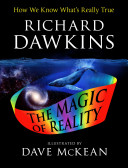How a Rainbow Works
If you want to see a rainbow you ' have to have the sun behind you when you look at a rainstorm. Each raindrop is more like a little ball than a prism, and light behaves differently when it Sits a ball from how it behaves when it hits a prism. The difference is that the far side of I raindrop acts as a tiny mirror. And that is /hy you need the sun behind you if you want 0 see a rainbow. The light from the sun turns somersault inside every raindrop and is reflected backwards and downwards, where it hits your eyes.
Here's how it works. You are standing with the sun behind and above you, looking at a distant shower of rain, The sunlight hits a single raindrop (of course it hits lots of other raindrops too, but wait, we're coming to that). Let's call our one particular raindrop A. The beam of white light hits A on its upper near surface, Adhere it is bent, just as it was on the near surface of Newton's prism. And of course the red light bends less than the blue, so he spectrum is already sorting itself out. Now all the coloured jams travel through the raindrop until they hit the far side. stead of passing through into the air, they are reflected back towards the near side of the raindrop, this time the lower part i the near side. And as they pass through the near side of the raindrop, they are again bent. Again the red light bends less than the blue.
So, as the sunbeam leaves the raindrop, it has been splayed out into a proper little spectrum. The separated coloured beams, having doubled back around the inside of the raindrop, re now hurtling back in the general direction of where you are standing. If your eye happens to be in the path of one of those beams, say the green one, you'll see pure green light. somebody shorter than you might see the red beam coming from A. And somebody taller than you might see the blue beam from A.
Nobody sees the full spectrum from any one raindrop. Each of you sees only one pure colour. Yet all of you say you see a rainbow, with all the colours. How come? Well, so far, we have only been talking about one raindrop, called A. There are millions of other raindrops, and they are all behaving in the same way. While you are looking at A's red beam, there is another raindrop called B, which is lower than A. You don't see B's red beam because it hits you in the stomach. But B's blue beam is in exactly the right place to hit you in the eye. And there are other raindrops lower than A but higher than B, whose red and blue beams miss your eye but whose yellow or green beams hit your eye. So lots of raindrops together add up to a complete spectrum, in a line, up and down.
But a line up and down is not a rainbow. Where does the rest of the rainbow come from? Don't forget that there are other raindrops, stretching from one side of the rain shower to the other and at all heights. And of course they fill in the rest of the rainbow for you. Every rainbow you see, by the way, is trying to be a complete circle, with your eye at the centre of it - like the complete circular rainbow you sometimes see when you water the garden with a hose and the sun shines through the spray The only reason we don't usually see the whole circle is that the ground gets in the way.
Notes:
A fantastic explanation of how sunlight reflects off of raindrops to form a rainbow, which would be a rain-circle if the ground didn't get in the way.
Folksonomies: science rainbow explanations prism
Taxonomies:
/health and fitness/therapy (0.518356)
/technology and computing/consumer electronics/camera and photo equipment/cameras and camcorders/cameras (0.334452)
/science/weather (0.325029)
Keywords:
raindrop (0.916210 (positive:0.060846)), particular raindrop A. (0.792543 (neutral:0.000000)), rainbow (0.780344 (positive:0.006080)), raindrops (0.683268 (positive:0.067517)), single raindrop (0.677429 (positive:0.459763)), red beam (0.674627 (negative:-0.237064)), complete circular rainbow (0.599986 (positive:0.659280)), separated coloured beams (0.585208 (neutral:0.000000)), blue beam (0.577331 (positive:0.774487)), proper little spectrum (0.566613 (negative:-0.532170)), red light (0.562016 (negative:-0.267977)), pure green light. (0.556504 (neutral:0.000000)), Rainbow Works (0.530666 (positive:0.694860)), sun (0.498189 (negative:-0.029656)), fantastic explanation (0.478714 (positive:0.694860)), tiny mirror (0.465152 (positive:0.591898)), side. stead (0.464614 (negative:-0.249824)), distant shower (0.460293 (negative:-0.218509)), coloured jams (0.459992 (negative:-0.249824)), little ball (0.459547 (neutral:0.000000)), eye (0.458786 (positive:0.143833)), general direction (0.451496 (neutral:0.000000)), pure colour (0.447210 (neutral:0.000000)), right place (0.445812 (positive:0.774487)), green beams (0.441699 (neutral:0.000000)), blue beams (0.441309 (negative:-0.390639)), rain shower (0.440605 (negative:-0.237354)), way (0.435586 (positive:0.659280)), complete spectrum (0.432051 (positive:0.258106)), complete circle (0.429679 (neutral:0.000000))
Entities:
Newton:Person (0.997104 (neutral:0.000000))
Concepts:
Color (0.951576): dbpedia | freebase
Rainbow (0.931016): dbpedia | freebase | opencyc
Light (0.749330): dbpedia | freebase | opencyc
Eye (0.590337): dbpedia | freebase | opencyc
Sunlight (0.587636): dbpedia | freebase | opencyc
Book of Optics (0.566582): dbpedia | freebase | yago
Sun (0.532166): dbpedia | freebase | opencyc
Rain (0.524582): dbpedia | freebase | opencyc






